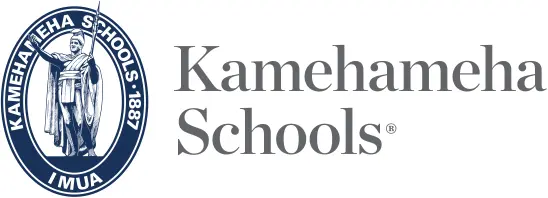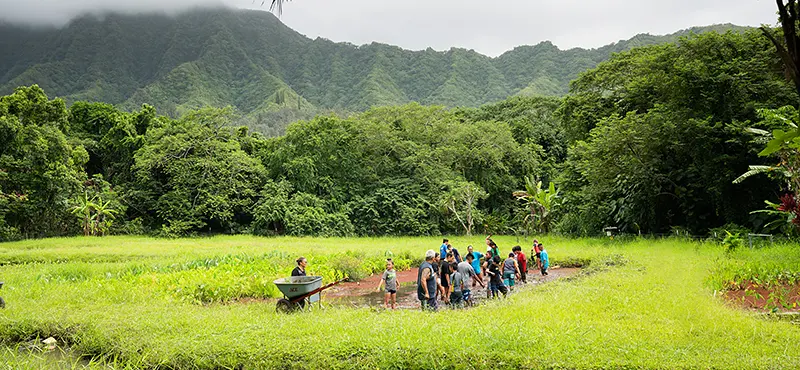Pauahi’s European Travel Journal 1875-1876
Ireland
Sources: Pauahi by George Kanahele, Chapter 5: Revelations of an Odyssey
Student transcriptions from Ka Moi, 1935-37
Transcriptions of Dani Gardner, KSG 1961
Please cite: Kamehameha Schools Archives when using information from this website
Disclaimer: all images of Europe are from the Internet to enhance the text
July 16, Friday, 1875 in Cork, Ireland
This is an eventful day! We arrived off the harbor about 4 o’clock in the afternoon–and heard the guns off the port which commanded the entrance to the harbor, firing targets right across the entrances. Presently the little brig, “Ivan,” came out to our vessels to fetch ashore those passengers who were intending to land there. There were about forty of us who did so and as we got clear of the “Bothinia” the gentlemen of our country gave three cheers which were responded to most heartily by those on the “Ivan.” They all crowded (the whole ship’s company) on this side and waved over and over again their handkerchiefs to us as we steamed in towards the town. We all felt very, very sorry to leave them for we were beginning to feel acquainted with each other and to like some of them exceedingly. The scenery around us, as we sailed up the beautiful bay of Queenstown, was charming, the harbor dotted with vessels of all kinds, and about 5 o’clock, we came to the landing and there for a while were in the clutches of the customs house officers, but they proved not to be very bad…
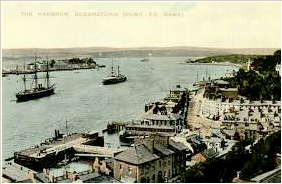
We soon learned that the boat which was to take us to Cork was not yet in, but would be at the landing in about two hours, so we decided to have a ramble around the town in one of the vehicles of the country, called a “jaunting car.” These “jaunting cars” are very funny looking things, being a two wheeled contrivance. The driver sits on a high seat in front and the passengers sit on the sides of the vehicles back to back, there being only room for two on each side, and as the driver starts off (generally with a snap at the animal ) with a jump of the horse there is a general holding on, to everything one can get hold off and you feel at the very start as if you would every instant be bounced off the seat; but after a little experience you begin to have a little confidence in yourself and the machine, and you begin to laugh at the novelty of your position and the ridiculousness of it. Indeed the whole thing is irresistibly droll and I shall never forget my first impression of these “jaunting cars.” I believe they are peculiar to Ireland.
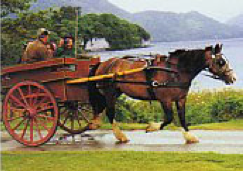
Well accustomed to our mutton, we soon began to feel a little at home (although you must all the time hold on for there is no other way of “keeping you and I’) and to enjoy the lovely scenes around us–for the town is situated on the side of a hill, and the houses are built on terrace after terrace with beautiful gardens in front, surrounded by hedges of ivy, hawthorn and other beautiful plants. The lower terraces are of course occupied by shops, warehouses and the “poor Irish”–but the residences of the “well to do” classes are very beautiful. Many people (the men) do business in Cork, and return at night to their homes in Queenstown. Our side trip (we stopped for a few minutes at a garden and reveled in eating strawberries and gooseberries) was most enjoyable and at 7 or half-past the boat which was to take us to cork arrived at the landing. We all embarked and steamed for the River Sei, for about two hours’ sail or steam before arriving in Cork. We were in a fairyland. The scenery each side of the sweet river is perfectly lovely, on one side for a considerable distance the hills are high and in high places, rather precipitously, the residences are on the slopes, and all have lovely gardens, and here and there are fine forests. On the other side the land is not so high but dotted with houses and gardens, and beyond are valleys and hills all under cultivation as far as the eye can see. And now and again you see castles and huts covered with ivy. I thought I never saw anything so picturesque in all my life. When we arrived in Cork, it was nearly 10 yet it was still light for the twilights are very long in this part of the world and the coachman with the omnibus from the “imperial Hotel” where we had sent a telegram for rooms was waiting for all those who were to patronize this establishment. We drove up to the hotel, had a bath, supper and to bed.
Saturday, 17th
Today, after breakfast, we took a jaunting car, on a visit to Blarney Castle. Mr. Pithe, the son of an author, and one of our fellow passengers occupied the front seat in the car. After leaving the heart of the city, we soon came in sight of the river Lee, and our car for a considerable distance laid along, in parallel with it only on a much higher elevation, and commanded not only the river, which meanders through the hills and dales, but the country beyond all highly cultivated. The views were charming–we passed elegant residences, porters’ lodges and so forth, and such lovely trees with twigs clinging to them, and running over the walls mixed with hawthorne, roses, and other plants whose names I do not know–all growing on each side of the wall and affording the weary traveller with their pleasant shade–and from time to time the little river could be seen through the trees and so about 8 miles we enjoyed to the utmost this charming drive and this is called “Sunday’s Well Road” or “Blarney Lane.”
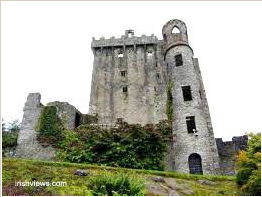
We alighted at the gates and were escorted to the castle by an old woman who glibly related to us, what she had already said scores of times to other people–the parting of the castle by the one who owned it. There is nothing now remaining of the castle but the tower, and on the very topmost is the celebrated “Blarney Stone,” held by iron bars, ready to tumble down from its dizzy height were it not–you enter first the ‘keep,’ and there is the other Blarney stone, which the old woman assured us had the same virtue as the other, of course we believed her! Consequently Bernice [Emma Bernice Bishop, Charles Reed Bishop’s niece] and I kissed it three times–the gentlemen went on up the stairway (not deigning to believe the old crony), which wound round and round an every little while you come to slits in the wall, which in olden times were used for shooting at the enemies with bows and arrows. This stone staircase extends easily to the top of the tower, 120 feet, and as soon as we had done our duty to the “keep” we followed the gentlemen, up the stairway. We went to the very op of the stairs, and I could go no further; and as we could not see the gentlemen anywhere, we began to be a little frightened for we were at a great height and we could not even see out, except into the court, which leads to the parapet, on one side of which hung the Blarney Stone–and as we could not even see the bottom of the court I told Bernice [Emma Bernice Bishop] we had better descend, which we did–and very tired were we for the stairway had 108 steps. We went out a little way on, admired the picturesque old castle with its massive gateway and green covered with ivy. For a remembrance of Blarney castle we bought some logwood ornaments which a man was selling right under the shadows of the thing, and he assured me that the oak log was here in Ireland during the flood. From thence we walked over the lovely grass and admired the stately old trees of “Blarney Grove” to the new Blarney castle just completed, and to be occupied next, month, our cicerone said by its owner. His name is Sir George Cathurst, who through his wife is the happy owner of this domain which was fit only for the royal palace of Mr. Carthy. This new castle is very handsome and grand. Outer grounds are not yet laid out–although the workmen are at work on the stables, and outer houses are completed, and stand some distance from the castle. We drove back to the Imperial by a different and most picturesque way– passed a lovely walk called the “Mardyke,” which is a mile long–and is shaded by fine elm trees, which form a beautiful arch overhead. In the afternoon we went out to St. Patrick Street, and street of Cork, and made some purchases.
Sunday, 18th
Went to St. Nicholas Episcopal church services and while there it began to rain. The building is an old structure but not very ornamental inside. This afternoon at three went to the Catholic church of St. Ann’s–but was disappointed there being no service. From there we took a cab and drove to the cemetery of St. Joseph–a wild looking place–and saw a very handsome tomb. In the center of the old yard is a tomb erected so the writing in the cross says, “by Father Matthews,” and we found offerings laid in this tomb by the ignorant Irish (buttons, pebbles, pins and what not, even a pair of old crutches) and thereby, receive healing of some maladies and they offer up prayers at that time. Truly the poor Irish are pitiable class–such poverty I never saw before and everywhere you go, the beggars are after you–heaping blessing upon you–all for a penny.
Monday, 19th
This is a very rainy morning and in consequence we have taken through tickets to Killarney, (instead of going to Macroon, as we had intended,) by rail and taking a carriage from there to the lakes which would have taken us two days. By all accounts the scenery on the way from Macroon by Glengare to the lakes is unsurpassed in the three kingdoms. We regret so much we were not able to come that way.
Royal Netria hotel
We arrived by rail (and by the way, it was our first experience in an English compartment carriage and we came to the conclusion that it was much better than the American cars,) today at noon. It was a very foggy, disagreeable sort of a morning when we left Cork, and all the way to the Town of Killarney. We had a whole compartment to ourselves and enjoyed the privacy very much. From the station we came in the hotel omnibus, a most beautiful view on the way. It is quite a large building (the hotel) and the grounds are well laid out, near the house are flower beds. Nearby is the mansion of the Earl of Krenman, who owns the last domain of this neighborhood–including the grounds on which stands this hotel. After a hasty lunch we took a jaunting car and a guide and started for sight-seeing on the lakes and neighborhood. We drove through lovely lanes embowered with trees on each side. All this property is owned by the Earl of Krenman. [ireland6] We drove through Mr. Herbert’s property (he is a prominent business man) for miles until we came to the beautiful Tree Falls. We got out and went up to look at them. The scenery was perfectly exquisite. After a few minutes, retraced our steps to the car and were befriended by two beggar women to buy some milk and they were so persistent that they rant after us for some distance when we had told them over and over again that we did not want any. We then drove through the private grounds of Mr. Herbert’s estate and passed the mansion, called Muckrons’ Mansion [Muckross House]. It is a stately house built in the Elizabethan style of architecture–and the trees in the domain are magnificent. We drove on for a while around the border of the Earl of Krenman’s until we came to the ruins of one of the most interesting places–Muckron’s abbey–and most picturesque of all the ruins in Ireland. It is an old abbey built in the eleventh century by the Franciscan monks. It was owned by the McCarthy’s—ancient kings of Ireland—and in the center of the chapel is the tomb of one of the McCarthy men and that of Mr. Donoghue—another of the royal race of Ireland. We walked from this chapel into the monks’ courtyard, in the middle of which is an ancient yew tree, several centuries old, and around this court is a covered way with arches in front looking into the court. The old monks formerly took their exercises there and their meditation and reading while the service was going on in the adjoining chapel. We climbed up the old stone staircase and came into the reception room, the dining room, and into a long room formerly divided into cells, on one side of which was a row of small windows and we then climbed down again. Our guide showed us the trunk of an ivy cut off a little way from the ground and the end of this trunk has formed into a shape very like a human head but more worth seeing. The opening showed the tongue and the neck, a grotesque looking thing, and it grew into this naturally. We could not help thinking that art did something towards it. The whole of the pile is of course roofless and covered with ivy. Mr. H. tried to keep it in a state of preservation.
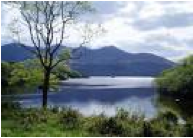
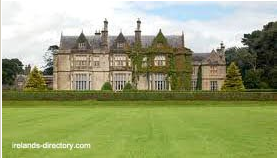
We went back again past the mansion and drove on for a while thro’ forests of trees and ferns, with wild flowers growing on each side of the way. When we came on the lake again, we dismounted and walked up a few steps to the gardener’s cottage—a picturesque looking building in all and quite neat inside with well-kept little flower garden in front. From here we got into the boat which had been sent to meet us, and we rowed across past Lady Kinmore’s cottages, until we got near the mountain and on this side our guide blew the bugle so that we might hear the echoes. It was perfectly splendid. It sounded as if there were several bands playing which was caused by the re-echoing of the mountains. This lake was smooth as a mirror and the scenery around was perfectly exquisite—the island here reflected in the water and the foliage grew right down to the water’s edge. We rowed on to the O’Sullivan’s cascade— it was very pretty but nothing we could compare to some of our waterfalls at home. From hence we went to the Sweet Inn’s Island, a most lovely island in which is an old ruin said to have been founded by St. Fernian in 600. Only the walls were standing and a picturesque looking ruin of a small chapel, which was a few steps from the landing. We walked the whole length of the island under fine old trees—the island is used as a sheep pasture or the Earl of Kenmore, and from the looks of the sheep they looked so well adapted in that purpose. It was on this island that the “Annals of…..”were written and was formerly the seat of Carring in Ireland where people came not only from Ireland, but from all parts of Europe for their education. We left this place with regret and saved our rest for our hotel—after a most enjoyable afternoon. At 1 o’clock we went to the table d’hote and dinner there was nice—the dining room of this hotel is very pleasant and looked right out on the lake where you can admire the view to your hearts content at the same time administering to the comforts of the hotel.
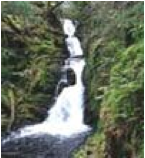
Tuesday, 20th
We arrived by rail (and by the way, it was our first experience in an English compartment carriage and we came to the conclusion that it was much better than the American cars,) today at noon. It was a very foggy, disagreeable sort of a morning when we left Cork, and all the way to the Town of Killarney. We had a whole compartment to ourselves and enjoyed the privacy very much. From the station we came in the hotel omnibus, a most beautiful view on the way. It is quite a large building (the hotel) and the grounds are well laid out, near the house are flower beds. Nearby is the mansion of the Earl of Krenman, who owns the last domain of this neighborhood–including the grounds on which stands this hotel. After a hasty lunch we took a jaunting car and a guide and started for sight-seeing on the lakes and neighborhood. We drove through lovely lanes embowered with trees on each side. All this property is owned by the Earl of Krenman. [ireland6] We drove through Mr. Herbert’s property (he is a prominent business man) for miles until we came to the beautiful Tree Falls. We got out and went up to look at them. The scenery was perfectly exquisite. After a few minutes, retraced our steps to the car and were befriended by two beggar women to buy some milk and they were so persistent that they rant after us for some distance when we had told them over and over again that we did not want any. We then drove through the private grounds of Mr. Herbert’s estate and passed the mansion, called Muckrons’ Mansion [Muckross House]. It is a stately house built in the Elizabethan style of architecture–and the trees in the domain are magnificent. We drove on for a while around the border of the Earl of Krenman’s until we came to the ruins of one of the most interesting places–Muckron’s abbey–and most picturesque of all the ruins in Ireland. It is an old abbey built in the eleventh century by the Franciscan monks. It was owned by the McCarthy’s—ancient kings of Ireland—and in the center of the chapel is the tomb of one of the McCarthy men and that of Mr. Donoghue—another of the royal race of Ireland. We walked from this chapel into the monks’ courtyard, in the middle of which is an ancient yew tree, several centuries old, and around this court is a covered way with arches in front looking into the court. The old monks formerly took their exercises there and their meditation and reading while the service was going on in the adjoining chapel. We climbed up the old stone staircase and came into the reception room, the dining room, and into a long room formerly divided into cells, on one side of which was a row of small windows and we then climbed down again. Our guide showed us the trunk of an ivy cut off a little way from the ground and the end of this trunk has formed into a shape very like a human head but more worth seeing. The opening showed the tongue and the neck, a grotesque looking thing, and it grew into this naturally. We could not help thinking that art did something towards it. The whole of the pile is of course roofless and covered with ivy. Mr. H. tried to keep it in a state of preservation.

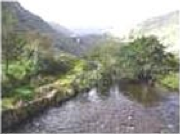
Wednesday, 21st, Dublin
We left dear Killarney this morning with regret. Along the way we saw cattles in the distance. We arrived at the station and drove up in a hack to this hotel called the Shelbourne hotel. It is a comfortable, rather old-fashioned in some respects, one. The table d’hote is excellent.
Thursday, 22nd
I did some shopping this morning and bought some pretty Irish laces. Drove from the stores to the Bank of Ireland where I drew some money. We were shown the room which was formerly the House of Lords in which hung large pieces of tapestry, each representing a historical picture. A statue of George III stands in an alcove where once stood the throne. It is a fine room. We then walked upstairs and saw the process of printing bank notes which was very interesting. From there we went in a car and drove to St. Patrick cathedral—a very elegant, large church. We walked around the statues of distinguished persons. Saw the stall of the Knights of St. Patrick. The coat of arms of each were painted on the back of the seat and above each being a banner. Beyond this is the Lady Chapel, which was formerly used as the chapter house. In the Knights of St. Patrick, one window struck me as superb. The colors were exquisite. We saw the well where St. Patrick baptized his converts. It is still used for baptisms.
When we came out to the car it was pouring and it thundered. We waited a while and when it began to clear we drove home. Had a good rest and when going down to dinner, met the Harpers who had just arrived from Killarney. After a delicious dinner we went to bed, tired but happy.





